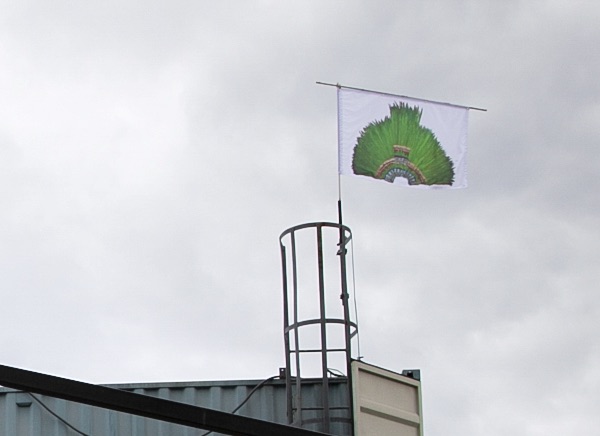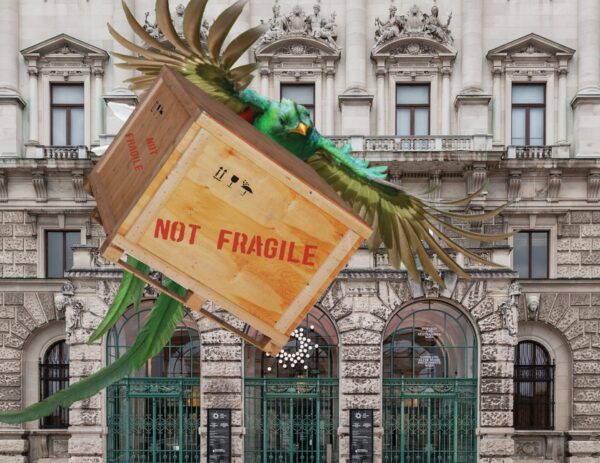Extractivism starts with desire.[i]
Rather than the focus on the extraction of minerals and labor as usual, this is an unconventional history of extractivism, focused on rebreeding for the purpose of extraction. The relationship between extractivism, potential extinction and restitution as a remedy is also unfolded here—not as a simple cause and effect, but to indicate a future trajectory for the zones in which extractivism has lain waste to resources, and where extinction already threatens many more species. In these cases, repatriation—often seen as highly political or cultural, and therefore not directly impacting food or fresh water supplies—becomes, in the context of extractivism and extinction, a way to provide a direct response and raise necessary awareness.

Fig. 1. Claudia Peña Salinas, Penacho flag for the exhibition Properties of a Presence at Fluc, Vienna, 2021, curated by the author.
New Copy/New Original
Where is the line when extractivism begins? Because as soon as a material is desired, is taken, the momentum of extractivism begins and has its own desiring mechanism. Even in, for example, the process of gifting—which would seem to be one of giving—often there is also a countermotion of taking. Think about Robin Hood—taking from one side and giving to the other. Or consider an example from the extraction of quetzal (Pharomachrus mocinno) feathers discussed in this chapter involving a feather headdress—known as el Penacho or quetzalapanecoatl, made from the feathers of the quetzal bird—at the Weltmuseum in Vienna.[ii] In lieu of repatriation of this unique item, that has been proposed many times since the 1940s, in 2024 the museum conservators research ways of making and gifting new featherwork to Mexico, This presents a conundrum: How can the museum source such a vast quantity of feathers? This challenge is not new—it’s like what happened in 1940 when the National Museum of Anthropology in Mexico City commissioned a copy of the quetzalapanecoatl.
Today the regulations on biosecurity (CITES—the Convention on International Trade in Endangered Species of Wild Fauna and Flora) specify that each feather must have its own passport to cross a border. As a result, it is not as straightforward as purchasing a large number of feathers; rather, a huge amount of paperwork is necessary for each specimen. As always with bureaucracy, there are ways around this. Ornithologist Nadja Ziegler advises that once the feathers are reintegrated into a sculpture, then they only need one passport, and no longer one for each feather.[iii] However, this new copy is not the original, which is the true star of this story. For that, we need to track back.
In 2021, the Austrian socialist parliamentarian Petra Bayr had an idea regarding the repatriation of the feather headdress, el Penacho, to Mexico. Currently held in the Weltmuseum in Vienna, it symbolizes the Aztec monarch, Motecuhzoma Xocoyotzin (Motecuhzoma the Younger, 1466–1520). A ceremonial headdress rather than a crown, it was taken after Motecuhzoma Xocoyotzin was murdered during the invasion by Hernán Cortés, the infamous conquistador who led the Spanish forces to conquer the capital of the Aztecs—present-day Mexico City. The return is now stymied by a scientific report made in 2012, which argued there was no way of transporting the object across to Latin America without damaging it beyond repair.[iv] This conservation argument still holds sway, while ethical ones have evaporated in the intensified heat of repatriations around the world.[v]
Surely, the parliamentarian Bayr said, technology has moved on in the decade since the last scientific report was made saying the headdress was too fragile to travel. If one can protect a person jumping out of the sky, or transport other fragile art works around the world, this object could indeed be transported. A commission was launched, and a meeting was held at the Weltmuseum in Vienna on October 17, 2022. I was invited to attend as a scientific expert, along with parliamentarians engaged in the debate on the requested inquiry into the return of the headdress. The goal of the commission was to assess the renewed request tabled by Bayr for repatriation, who presented my book The Contested Crown, as evidence for the return argument.
Despite my familiarity with the complexity of the debate, I was completely unprepared for the artillery of negativity that would be unleashed on us. In response to the request to reassess the claim the museum had made in 2012, conservators at the Weltmuseum claimed that even opening the vitrine would endanger the object’s very existence, and that threat could not be justified by what they described as whims and desires related to an Indigenous inheritance that is still alive and well.[vi]
To deepen their argument for retaining the headdress, conservators at the Weltmuseum brought pieces of quetzal feathers in a glass bottle, a little like a reliquary, and passed them around the assembled hushed and attentive parliamentarians. Close-up photographs of the back of the crown before its restoration and cleaning were also circulated. They chose the “before” rather than the “after” shots of their work for dramatic effect. “Look how shabby and pitiful these materials are,” the photographs seemed to say. “We must salvage this primitive corpse, as seen in these autopsies.” These were the messages of the conservation team from the museum, designed to bolster the notion that fragility and death are the major components of our care for the past. This resulted in the motion for repatriation being postponed.
Those of us questioning the objectivity of the scientific report—clearly commissioned for political ends—were cast as akin to flat Earth theorists.[vii] I realized that only “hard science” could counter even this bogus scientific report, and I therefore continued my search for engineers that could accurately calculate the vibrations that occur during transport and assess the risk they pose to the Penacho. At the time of writing, I have just finished building a prototype based on findings of several international engineering experts and designed by Kerstin Kracht, whom I found through the British Museum where she worked as their engineering expert for transporting fragile museum objects (particularly relevant was a successful return of feathers over 250 years old from London to Tahiti).[viii]
In fact, an engineering team led by Alejandro Ramirez in Mexico City also already developed multiple models for transporting old feathers safely, with the Penacho in view as he was also part of the binational commission in 2012. The most recent generation is robotic, replete with sensors that allow the inside of a transport container to respond to movements created in the journey. Meta-materials that dissipate the energy of impact on a fragile item are part of the cutting-edge experiments being made in Mexico City (and exported to the Getty in Los Angeles).
The simplest technology, which is also the one I am using for the Penacho, are wire springs that dampen the loads. For me, following the advise of Kracht, the minimal and analogue solution is the strongest (most cost effective, elegant concept). Ramirez’s laboratory in UNAM (Universidad Nacional Autónoma de México) is full of prototypes, including a 3-month long test of vibration and friction of feathers on metals (as the gold pieces on the Penacho have), all proving that it would not be destroyed on route to Mexico. When I speak to him, Ramirez’s is pleased with the objectivity of his findings, these hold more weight than political utterances he says with a smile (featured in film released on September 16, 2025 at Wien Woche).[ix]
I worked closely with the German engineer Kracht to design my Penacho counter-vibration crate so the argument of Mexican nationalism is also eliminated.[x] Together with her engineering data, I have now built a case that would transport the feathers safely, in a way that is neither dangerous nor prohibitively expensive. To add further confidence, I am building it in the very workshop where the Penacho’s last moves around the museum building in 2012 were also made through special ramps with the team of Winter Art, expert art handlers. In partnership with WIENWOCHE, an activist art festival in Vienna, this project will launch September 13, 2025 with a full-scale demonstration of the device for countering vibration and enabling repatriation to Mexico. Within the history of WIENWOCHE, this project builds upon an anti-extractivist curatorial line that runs from Karin Reisinger hosting Sami writer Katarina Pirak Sikku and a female embroidery club making works on mining in 2022, to remineralization in 2023, the anti-extraction peoples school project in 2024, and now our part in the laboratory for anti-imperialist solidarity in 2025.[xi]

Fig. 2. Eternos Retornos, project poster for WIENWOCHE by the author with Verena Melgarejo Weinandt, 2025.
[i] Thanks to Jelena Micić, director of WIENWOCHE Festival for Art and Activism, for her comments on this point and support of the project to build a transport container for the 2025 iteration of the festival..
[ii] Quetzalapanecoatl is the Nahuatl (Aztec) name for the feather headdress that is known popularly as el Penacho or Federkopfschmuck in German, as I will discuss later on in this chapter.
[iii] Nadja Ziegler is the founding director of the organization for Papageienschutz (parrot protection), Vienna. This was mentioned during a tour given in 2024. For more on the organization, see https://www.papageienschutz.org/, accessed May 16, 2025.
[iv] The significance of the Penacho and the complex history of its repatriation, as well as the interests of the parties involved, is the subject of my book The Contested Crown: Repatriation Politics between Europe and Mexico (Chicago: Chicago University Press, 2022). Chapter 4 details what happened in 1930-40s Mexico when a copy was made to replace the failed repatriation to the National Museum of Anthropology in Mexico City. Chapters 1–3 tell the story of the binational commission and report made in 2012. The current debate and response in 2024 is what this chapter contributes to this longer history.
[v] Françoise Vergès, A Programme of Absolute Disorder: Decolonizing the Museum, trans. Melissa Thackway (London: Pluto Press, 2024); Bénédicte Savoy, Afrikas Kampf um seine Kunst. Geschichte einer postkolonialen Niederlage (Munich: C. H. Beck, 2021); Alexander Herman, Restitution: the Return of Cultural Artefacts (London: Lund Humphries, 2021); Khadija von Zinnenburg Carroll, ed., Tupaia, Captain Cook and the Voyage of the Endeavour: A Material History (London: Bloomsbury Press, 2022); Khadija von Zinnenburg Carroll, “El Penacho, the lack of provenance and the gains of decolonization: Ethical, technical or political reasons for restoration,” in Das Museum im kolonialen Kontext, ed. Pia Schölnberger (Vienna: Czernin Verlag, 2021), 431–448.
[vi] A good counter argument to this is described in Kyle Powys Whyte, “Our Ancestors’ Dystopia Now: Indigenous Conservation in the Anthropocene,” in Routledge Companion to the Environmental Humanities, ed. Ursula Heise et al. (New York: Routledge, 2017), 206–215.
[vii] Eva Blimlinger, Austrian Green party politician, in conversation with the author, October 17, 2022.
[viii] Tupaia’s Mourner’s costume flew with only one feather becoming dislodged in the process. Interview of the author with curator for Pacific Julie Adams, British Museum, 13 May 2025. See also: https://www.britishmuseum.org/research/projects/protecting-collections-vibration-during-transport and
https://britishmuseum.iro.bl.uk/concern/articles/032839c9-1dad-4f83-874b-b7e1506adfce?locale=en
[ix] The interviews span from 2017 till 2024 and are recorded for a film I’m making on the subject. The UNAM students working in test rigs with Alejandro Ramirez are: Armenta Márquez Alí Eduardo, Pérez Cinencio, Daniel Josué, Michel Juárez, Miguel Adrián, all with several publications on the subject forthcoming.
[x] For more info see Khadija von Zinnenburg Carroll, “Risk Reassessment and Safe Transportation for the Penacho,” Repatriates, November 6, 2023, https://repatriates.org/mexico/risk-reassessment-and-safe-transportation-for-the-penacho/.
[xi] “On Living in Extractive Areas,” WIENWOCHE, accessed May 19, 2025, https://www.wienwoche.org/de/archives/2022/programm-2022/projekte-22/fences-insects-embroideries-material-communities/on-living-in-extractive-areas.
